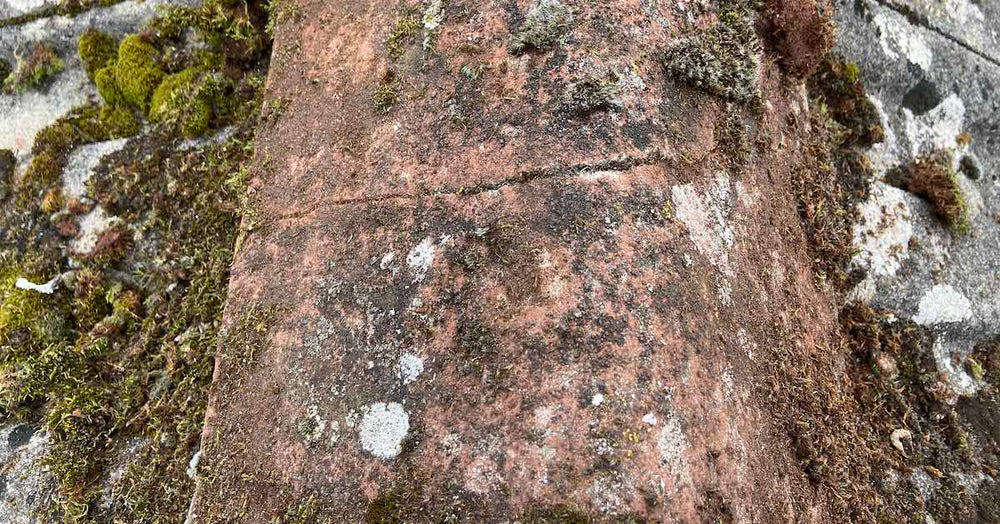
Moss feeds on mineral salts and requires light and moisture to grow. The biofilm of algae, lichen, fungus and mould holds moisture and so creates the perfect environment for moss to grow and reproduce.
Moss typically consists of a green cushion of spiky tufts but may also be low and spreading.
Moss is usually found on surfaces where salts, soil and dirt have accumulated and commonly occurs on roofing materials.
Moss will usually become brown when it dries.
When does moss appear on a building?
Moss will normally start to appear around a new property after about 2-7 years. And it particularly loves to grow on tarmac and roof tiles.
On many buildings moss will start to grow on the roof, spread from the roof to the gutters, and then fall onto footpaths and drives.
Moss can spread very quickly.
Watch the video below to learn about soft washing and moss
Moss holds water, which can add weight to a roof – causing stress on the structure. It expands when frozen and this expansion can damage gutters and tiles.
Moss can make footpaths, driveways and playgrounds extremely slippery and dangerous.
Tarmac will typically require two treatments of Benz Bio Cleanze in the first year to remove the biofilm that creates an environment for the growth of moss. Thereafter a once yearly application should be sufficient.
Concrete tiled roofs often last longer – sometimes as long as 5-10 years depending on the local environment and prevailing weather – before a new biofilm becomes established and re-spraying with Bio Cleanze becomes necessary.
Moss and the legal situation concerning soft washing with DDAC biocide
Until June 2015 DDAC, the active ingredient in Bio Cleanze, was extensively used to kill and control moss, and was widely promoted as a moss killing & control agent.
But since June 2015 moss has been categorised as a “plant” and therefore from this date comes under the Plant Protection Products (PPP) regulations.
Quick tip: As far as we know all that changed was the movement of all DDAC biocides to a different administrative category with different labelling criteria. Everything else remains the same including the chemical composition of Bio Cleanze and its effect on other unwanted and unsightly biological growths that often present dangers for humans and building structures.
Now, because of this change of legislation, only manufacturers of herbicides (aka “weedkillers”), which are often quite unhealthy for humans and bad for our environment, can claim to kill and control moss.
From June 2015 no DDAC biocide manufacturer has been legally allowed to tell you that a biodegradable biocide, such as Bio Cleanze, kills and controls moss.
Rest assured that the formula and contents of Bio Cleanze remains the same as it was prior to the change of legislation – and you can therefore continue using it to control all manner of other biological growths on exterior hard surfaces such as drives, paths, car parks, tennis courts, roofs, walls, render, boats, decking and other timber structures such as sheds and fences.
Scientific information about moss
Moss, from a regulatory standpoint, refers to the biological division of "Bryophyta". There are many types of growths described in common language by the word "moss" which are not, scientifically speaking, moss.
Many biological growths that are often, inaccurately, called "moss" are not actually moss because they are not "Bryophyta".
In everyday speech the word "moss" is frequently used describe a variety of biological growths, many of which do not fit the true scientific description of "moss".
For example, "Irish moss" is just another name for red algae. A similar mistake occurs when using the names "Spanish moss, beard moss, Iceland moss, oak moss and reindeer moss" which are actually names of lichens.
And the “moss” found on the north side of trees is actually the green algae known as Pleurococcus.
Click here to discover many more examples of when "moss" is not actually moss ...
Important: The term "moss" as used to describe various biological growths in Benz marketing materials and technical data refers only to growths not belonging to the biological division of Bryophyta. Bryophyta is a plant and, because it would be killed by our biocides, should not be targeted for treatment.
We hope this information is helpful and sincerely wish you great success in your soft washing business,
The Benz team



Responses
Leo
Hi K – and thank you for your enquiry. The first step is to move any transportable plants out of reach from spray drift and run-off. Then apply the principles of protecting plant life that we outline here (copy & paste this link into your web browser):https://www.benzsoftwash.com/pages/plant-life?pos=2&_sid=b9a47aa11&ss=r
February 14, 2022
K s
I have a lot of plants and flowers at surrounding my house , does Benz kill the plants and flowers if I were to wash the roof and the solution
We’re to drop on to my garden lawn with plants and flowers ??
February 14, 2022
Ethanael
I’m so glad I found my soultion online.
May 10, 2017
Leave a comment